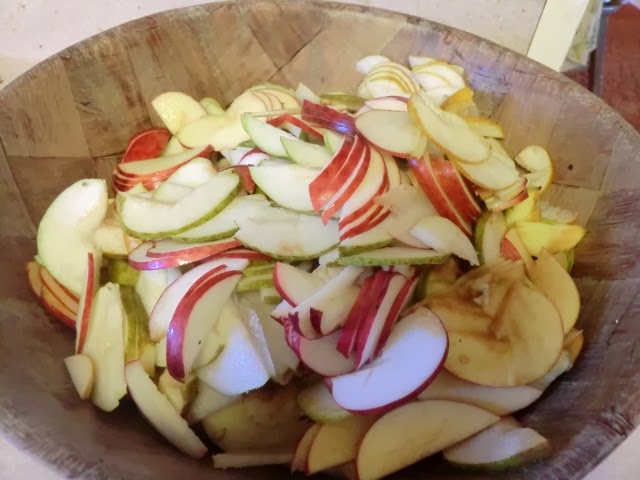Well, I finally decided to write a food blog, mainly because I am on this diet that is supposed to cure me of ulcers. Actually, I think that it's working. So... one of the things that I had to deal with was the fact that I couldn't eat the applesauce that I love to make because it's loaded with lemon juice and one of the rules of the anti-ulcer diet is...
NO ACIDIC FOODS...
or I will start writhing, screaming, crying... you get the picture... the activities that I indulged in before I went to the hospital and was diagnosed with the ulcers...
OK... enough about ulcers...
Food is more fun...
Today, the focus is on what you can do with apples and pears to turn them into a delicious, nonacidic treat...
.jpg) |
| Here are some apples and pears that I had picked from a variety of trees |
The best thing to do is to start with a variety of apples and pears. It's good to mix types, to get a better flavor. My mom's favorite apples are Granny Smith, Empire, and MacIntosh. She gets those from the store. It's easier to know what types of apples and pears you are getting when you buy them in the store. But it's not as much fun. It's autumn so I like to collect apples that I pick from the trees or find on the ground. I know a lot of people who will discard apples and pears if they land on the ground. All you have to do is wash them, and they are fine.
I wash the apples and pears and then I core them and slice them and put them into a one quart measuring cup. I keep track of how many quarts of apples I cut up because that determines how much liquid I use for cooking.
.jpg) |
| four quarts of cored and sliced apples and pears... |
|
|
|
|
The coring and slicing is the most time-consuming part of the project.
Then you measure your liquid. I find that I need less liquid of I make pear-apple sauce than if I make applesauce. Pears tend to be somewhat liquidy and, since I don't want to drink my pear-apple sauce, I cut back on the liquid. The liquid that I used was part water and part apple cider. In the future, I will tweak this recipe so that it is all apple cider.
I then pout the liquid into a large pot and turn the heat fairly high so that the liquid will boil. This seems to take about six to eight minutes. Once the liquid is boiling, I add all of the fruit, turn the heat to medium, and cover the pot. After ten minutes, I check to see if there is enough liquid and I stir the apples and pears. I check every ten minutes as the fruit steam heats.
.jpg) |
| The apples and pears start to get soft... |
|
.jpg) |
| Cooking in steam and getting softer... |
.jpg) |
| At this point, the fruit is nice and soft and you are ready to move on to the next step... |
... which is to get out the food mill and a second pot and a trivet for the first pot and your big spoon... and this is the fun part... and a little magical...
I put the softened fruit into the food mill and start churning. It's fun and it's even good exercise.
This is the pear-apple sauce after it's gone through the food mill. My mother likes her pear-apple sauce (or her applesauce) smooth, so I put the sauce through the food mill for a second time.
Here we go! Finished and ready for the taste test. Bon appetit!!!






.jpg)
.jpg)
.jpg)
.jpg)
.jpg)